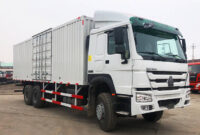1967 Ford Trucks For Sale: A Comprehensive Guide to Owning a "Bumpside" Classic pickup.truckstrend.com
The year 1967 marked a pivotal moment for Ford’s venerable F-Series pickup trucks, ushering in the highly anticipated fifth generation, affectionately known as the "Bumpside" era. These trucks, produced from 1967 to 1972, quickly earned a reputation for their robust construction, distinctive styling, and versatile utility. Today, 1967 Ford trucks for sale represent more than just vintage vehicles; they are cherished pieces of American automotive history, sought after by collectors, restorers, and enthusiasts alike. Their enduring appeal lies in a unique blend of classic aesthetics, a straightforward mechanical design that lends itself well to maintenance and customization, and a strong sense of nostalgia for a simpler time. Whether you’re a seasoned classic truck aficionado or a newcomer dreaming of owning a piece of the past, understanding the nuances of these iconic pickups is essential to making an informed and satisfying purchase.
The Enduring Appeal of the 1967 Ford F-Series: The "Bumpside" Era Begins
1967 Ford Trucks For Sale: A Comprehensive Guide to Owning a "Bumpside" Classic
The 1967 Ford F-Series, the inaugural model year of the fifth generation, introduced a host of significant changes that set it apart from its predecessors. Ford engineers and designers aimed for a more refined, spacious, and comfortable truck while retaining the F-Series’ legendary durability. The most notable visual change was the "Bumpside" styling, characterized by the prominent indentation running along the truck’s side panels, a design element that gave the trucks their enduring nickname.
Beyond aesthetics, the 1967 models boasted a wider cab, offering increased shoulder room and a more car-like interior experience. The larger greenhouse provided improved visibility, enhancing both safety and driving pleasure. Ford also focused on improving ride quality, incorporating new suspension components that made the trucks more comfortable for daily driving and long hauls. This combination of rugged utility and enhanced comfort struck a chord with buyers, cementing the 1967 F-Series’ place in automotive history and ensuring its continued popularity in the classic truck market. Their simple, honest design makes them incredibly approachable for DIY mechanics, while the vast aftermarket support allows for everything from faithful restorations to radical custom builds.
Understanding the 1967 Ford F-Series Models and Configurations
When searching for 1967 Ford trucks for sale, it’s crucial to understand the various models, body styles, and powertrain options available. This knowledge will help you identify the specific truck that best fits your needs and budget.
Models and Capacities:
- F-100: The half-ton pickup, the most common and popular choice, ideal for light hauling and general use.
- F-250: The three-quarter-ton model, offering increased payload capacity and a heavier-duty chassis for more demanding tasks.
- F-350: The one-ton workhorse, often found as a cab-and-chassis model, designed for heavy commercial applications or specialized bodies.

Body Styles:
- Styleside: The most popular bed option, featuring smooth, straight sides that integrated seamlessly with the cab’s lines. This is the modern-looking "fleetside" bed.
- Flareside: Also known as a "stepside," this traditional bed style featured separate, flared rear fenders and an exposed running board, giving it a more vintage and rugged appearance.
- Cab & Chassis: These were sold without a bed, intended for custom applications like flatbeds, utility bodies, or campers.
Engine and Transmission Options:
Ford offered a range of robust engines in 1967, known for their reliability and torque:
- Inline-Six Cylinders:
- 240 cu in (3.9L): A durable and economical base engine.
- 300 cu in (4.9L): A legendary workhorse, known for its incredible torque and longevity, often considered one of Ford’s best truck engines.
- V8 Engines:
- 352 cu in (5.8L) FE V8: A common V8 option, offering good power and a classic V8 sound.
- 390 cu in (6.4L) FE V8: A more powerful option, often found in heavier-duty trucks or those specified for more performance. (Note: While 390s were available, the 352 was more common for ’67, with the 390 becoming more prevalent in later years of the Bumpside run.)
Transmission options included various manual transmissions (3-speed, 4-speed, including "Granny Low" first gear options) and the Ford Cruise-O-Matic automatic transmission.
What to Look For When Buying a 1967 Ford Truck
Purchasing a classic truck requires a keen eye and a thorough inspection. Knowing what to look for can save you significant time and money down the road.
- Rust: The Number One Enemy: This is paramount. Inspect common rust areas:
- Cab Corners and Rocker Panels: These are notorious for rusting out due to water and debris accumulation.
- Floor Pans: Check under the carpet and floor mats.
- Fender Wells and Lower Fenders: Especially behind the front wheels.
- Bed Floors and Bed Mounts: Pay attention to where the bed meets the frame.
- Frame Rails: Look for excessive surface rust, cracks, or previous repairs.
- Engine and Drivetrain:
- Listen for unusual noises: Knocks, rattles, or excessive smoke upon startup.
- Check for leaks: Oil, coolant, transmission fluid.
- Examine fluid levels and condition: Are they clean or sludgy?
- Test drive: Ensure smooth shifting (manual or automatic), proper clutch engagement, and no excessive driveline vibrations.
- Suspension and Steering:
- Look for worn bushings, ball joints, and tie rod ends.
- Check for excessive play in the steering wheel.
- Listen for clunks or squeaks over bumps.
- Brakes:
- Check brake pedal feel: Spongy or hard?
- Inspect lines and hoses for cracks or leaks.
- Note if it’s still drum brakes all around or if it’s been converted to front discs (a popular upgrade).
- Electrical System:
- Test all lights (headlights, taillights, turn signals, brake lights).
- Verify gauges work.
- Look for frayed or spliced wiring, which can indicate previous shoddy repairs.
- Interior:
- Seat condition: Tears, springs, foam.
- Dashboard: Cracks, missing trim.
- Headliner and door panels.
- Functionality of heater, wipers, and other accessories.
- Documentation: Always ask for a clean title. Maintenance records, build sheets, or original owner’s manuals are a huge bonus.
Restoration vs. Driver vs. Project: Defining Your Purchase
Before you begin your search for 1967 Ford trucks for sale, determine your intentions and skill level.
- Fully Restored: These trucks command the highest prices. They are typically show-quality, meticulously restored to original specifications or tastefully restomodded. Ideal if you want to drive and enjoy immediately with minimal fuss, but be prepared for the premium cost.
- Good Driver: A solid, running truck that’s presentable but not perfect. It might have some minor flaws, dings, or a slightly worn interior. These are excellent for regular use, weekend cruises, and offer a great platform for gradual improvements. They strike a good balance between cost and usability.
- Project Truck: The most affordable option, but also the most demanding. These trucks often require extensive mechanical, body, and interior work. Perfect for the skilled DIY enthusiast with a significant budget for parts and a lot of patience. Be realistic about the time and money commitment involved. Many project trucks become abandoned if the scope of work is underestimated.
Many enthusiasts also pursue Custom Builds (Restomods), taking a solid driver or even a project and upgrading it with modern components like fuel-injected engines, independent front suspension, disc brakes, power steering, and air conditioning, blending classic looks with contemporary performance and comfort.
Finding Your 1967 Ford Truck: Where to Look
The digital age has made finding classic trucks much easier, but local connections remain valuable.
- Online Marketplaces:
- eBay Motors, Craigslist, Facebook Marketplace: Broad reach, but require careful vetting of sellers and vehicles. Be wary of scams.
- Specialized Classic Car Sites: Hemmings, ClassicCars.com, Bring a Trailer (for higher-end, vetted examples).
- Specialized Forums & Clubs: Websites like Ford Truck Enthusiasts (FTE) and Bumpside.com have dedicated classified sections where members often sell their trucks. These communities can also provide valuable insights and advice.
- Classic Car Dealers & Auctions: Dealers often offer thoroughly inspected and sometimes restored vehicles, but with a higher markup. Auctions can be exciting, but it’s crucial to inspect the vehicle beforehand and set a firm bidding limit.
- Local Classifieds & Word of Mouth: Don’t underestimate the power of local advertising, car shows, and networking within the classic car community. Sometimes the best deals are found close to home.
Practical Advice and Actionable Insights
- Set a Realistic Budget: Beyond the purchase price, factor in transportation costs, immediate repairs, insurance, registration, and potential upgrades. A good rule of thumb is to have at least 20-30% of the purchase price set aside for initial post-purchase expenses.
- Always Perform a Pre-Purchase Inspection (PPI): If you’re not mechanically inclined, hire a reputable classic car mechanic to inspect the truck thoroughly. This can uncover hidden issues and save you from costly surprises.
- Test Drive Extensively: Drive at various speeds, on different road surfaces, and pay close attention to how the truck feels, sounds, and handles.
- Research the VIN and Data Plate: Ford trucks have a detailed data plate on the driver’s door that decodes the VIN, engine, transmission, axle, and original color. Verify this information against the seller’s claims.
- Connect with the Community: Join online forums or local clubs. The collective knowledge of other 1967 Ford truck owners is an invaluable resource for parts, advice, and troubleshooting.
- Negotiate Wisely: Don’t be afraid to haggle, especially if you’ve identified areas needing repair during your inspection.
Common Challenges and Solutions
- Rust Repair: Extensive rust can be costly. Professional bodywork is expensive, but patch panels and full replacement panels are available for DIYers.
- Parts Availability: Generally, mechanical parts for these trucks are still readily available through auto parts stores and specialized classic truck suppliers. Reproduction body panels, trim, and interior components are also increasingly available, though some specific trim pieces can be harder to find.
- Modernizing for Daily Driving:
- Brakes: Conversion kits to disc brakes (especially front) dramatically improve stopping power.
- Steering: Power steering conversion kits make driving much easier.
- Air Conditioning: Aftermarket AC kits are available for comfort.
- Fuel Economy: Older carbureted engines are thirsty. Consider electronic fuel injection (EFI) conversion for better starting, performance, and efficiency, or even an engine swap for a more modern powertrain.
- Safety: These trucks lack modern safety features. Consider adding three-point seatbelts, brighter lighting, and ensuring all mechanical systems are in top condition.
1967 Ford Trucks For Sale: Estimated Price Guide
Please note: Prices for classic vehicles are highly subjective and depend heavily on condition, originality, modifications, regional market demand, and recent sales trends. This table provides a general estimate.
| Model & Body Style | Condition Category | Estimated Price Range (USD) | Key Considerations |
|---|---|---|---|
| F-100 Styleside (2WD) | Project | $3,000 – $8,000 | Significant rust, non-running or rough running engine, incomplete interior. Requires full restoration. |
| Good Driver | $10,000 – $25,000 | Running, driving, presentable but not perfect. Minor rust, some cosmetic flaws, reliable mechanicals. Good for enjoyment and light improvement. | |
| Restored/Custom | $30,000 – $70,000+ | Show-quality restoration or professional restomod. Excellent paint, body, interior, and often upgraded drivetrain/suspension. Prices can exceed this range for high-end builds. | |
| F-100 Flareside (2WD) | Project | $4,000 – $9,000 | Similar to Styleside, but Flaresides often command a slight premium due to their distinct classic look. |
| Good Driver | $12,000 – $28,000 | Well-maintained, unique appearance. | |
| Restored/Custom | $35,000 – $80,000+ | Highly sought after when perfectly restored. | |
| F-250/F-350 (2WD/4WD) | Project | $2,500 – $7,000 | Often more mechanically sound but cosmetically rougher than F-100s. Can be found cheaper due to lower demand for heavy-duty trucks as classics. |
| Good Driver | $8,000 – $20,000 | Solid work truck potential, or basis for a unique build. 4×4 versions typically fetch higher prices. | |
| Restored/Custom | $25,000 – $50,000+ | Less common to see fully restored, but can be impressive when done. 4×4 restorations are particularly valuable. |
Note: 4×4 models (F-100 4×4, F-250 4×4) generally command a 20-50% premium over their 2WD counterparts in similar condition due to their rarity and increased desirability.
Frequently Asked Questions (FAQ) About 1967 Ford Trucks
Q1: What makes a 1967 Ford truck unique compared to other Bumpside years (1968-1972)?
A1: The 1967 model year is unique due to its specific grille design, which features "FORD" lettering in the center of a horizontal bar grille. The parking lights are located above the headlights, unlike later years where they moved below. It also has specific interior door panels and dash trim that differ from subsequent years.
Q2: Are parts for 1967 Ford trucks easy to find?
A2: Generally, yes. Mechanical parts (engine, transmission, suspension components) are widely available through standard auto parts stores and specialized classic truck suppliers. Reproduction body panels and interior components are also increasingly available, though some specific trim pieces might require searching on classic parts forums or salvage yards.
Q3: What’s the average fuel economy for a 1967 Ford truck?
A3: Fuel economy is not a strong suit of these older trucks. Depending on the engine (V8s are thirstier than inline-sixes), axle ratio, and transmission, you can expect anywhere from 8 to 15 miles per gallon (MPG). Upgrading to electronic fuel injection (EFI) can slightly improve efficiency.
Q4: Can I daily drive a 1967 Ford truck?
A4: Yes, many people daily drive their Bumpside trucks. However, for regular use, it’s highly recommended to perform key upgrades such as disc brake conversion, power steering, and potentially modern tires. Regular maintenance is crucial, and be prepared for a less refined ride compared to modern vehicles.
Q5: What are the most common rust spots on these trucks?
A5: The most common rust spots are the cab corners, rocker panels, floor pans, lower front fenders behind the wheels, and the bed floor/bed supports. Always check these areas thoroughly.
Q6: Is a 1967 Ford truck a good investment?
A6: While classic vehicles can appreciate in value, it’s best to view owning a 1967 Ford truck as a hobby and a passion rather than a pure financial investment. Values have been steadily increasing for well-maintained and restored examples, but the primary return is often the enjoyment of ownership.
Q7: What’s the difference between a Styleside and a Flareside bed?
A7: A Styleside bed has smooth, straight sides that are integrated with the cab’s styling, similar to modern pickup beds. A Flareside bed (also known as a stepside) has separate, external rear fenders and a step located in front of the rear wheel, giving it a more traditional and distinct vintage look.
Conclusion
The 1967 Ford F-Series trucks stand as enduring symbols of American automotive craftsmanship, blending rugged utility with a timeless design that continues to captivate enthusiasts. Their "Bumpside" styling, robust powertrains, and straightforward mechanicals make them an attractive prospect for anyone looking to own a piece of history. Whether you envision a meticulously restored showpiece, a reliable daily driver, or a custom-built restomod, the market for 1967 Ford trucks for sale offers a wide array of options to suit various budgets and aspirations.
By understanding the different models, knowing what to look for during inspection, and setting a realistic budget, you can navigate the classic truck market with confidence. While challenges like rust and the desire for modern amenities may arise, the vibrant community and readily available parts offer viable solutions. Owning a 1967 Ford truck is more than just acquiring a vehicle; it’s an investment in a rewarding hobby, a connection to automotive heritage, and an opportunity to create something truly unique that will turn heads for years to come.


